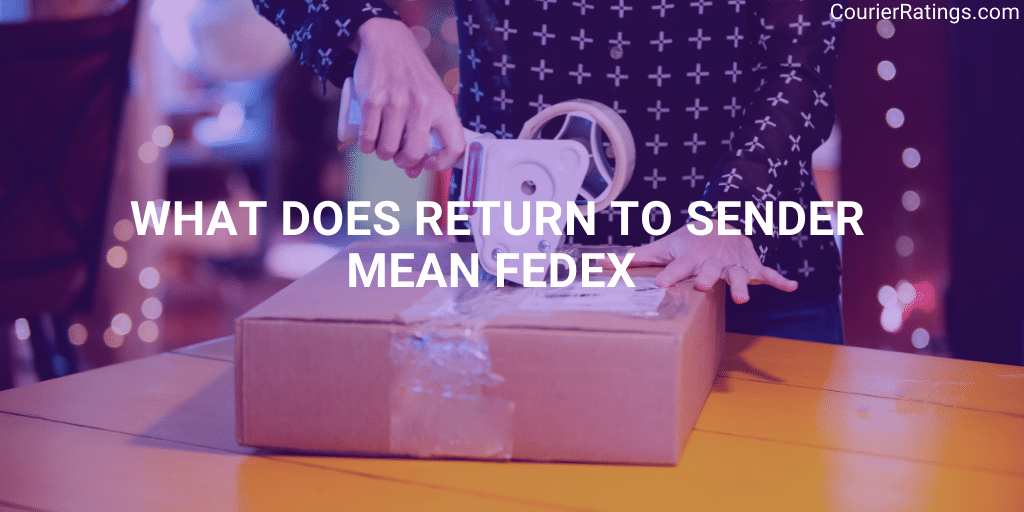Have you ever eagerly anticipated the arrival of a FedEx package, only to receive a notification that it’s been returned to the sender? Frustration and confusion can quickly set in, leaving you wondering, “What does ‘Return to Sender’ mean, especially in 2024?”
In today’s digital age, where online shopping and package deliveries have become an integral part of our lives, the last thing you want is for your eagerly awaited parcel to take an unexpected detour back to the sender.
So, if you’ve ever encountered the “Return to Sender” status with FedEx, rest assured we’ve got the answers you need. In this article, we’ll dive deep into the reasons behind FedEx’s return to sender policy in 2024, explore common scenarios leading to such outcomes, and provide you with practical insights on what to do if your package falls into this category.

Key takeaways
- “Return to Sender” in FedEx 2024 means undelivered packages; understand why to prevent hassles.
- FedEx holds packages for seven days before returning; act promptly to avoid returns.
- Proper address, packaging, and communication are vital for successful FedEx deliveries.
- Whether sender or recipient, know how to manage and prevent “Return to Sender” situations for smoother shipping experiences.
What Does Return To Sender Mean FedEx In 2024?
In 2024, “Return to Sender” in FedEx status signifies that a package couldn’t be successfully delivered to the intended recipient and is being sent back to the shipper.
FedEx’s “Return to Sender” label is a straightforward but crucial aspect of their package delivery process. A package with this tag usually results from various common scenarios, such as an incorrect address, insufficient postage, or the recipient’s unavailability.
In the digital age, where precise shipping is essential, FedEx takes these measures to ensure packages reach their intended destinations efficiently. Let’s explore the reasons behind this status and what you can do if FedEx tagged your package as “Return to Sender” in 2024.
Can FedEx Send the Package Back to the Sender?
Certainly, FedEx can send the package back to the sender. When a package is marked as “Return to Sender,” it essentially means that FedEx has encountered an issue preventing successful delivery and they are taking the necessary steps to return the package to its origin.
This return process is integral to FedEx’s commitment to efficient package management. Packages may be returned for several reasons, including an incorrect or incomplete address, insufficient postage, or the recipient’s unavailability.
In each case, FedEx’s primary goal is to ensure that packages are delivered accurately and securely.
So, if you ever find yourself in a situation where your FedEx package is marked as “Return to Sender,” rest assured that FedEx will make an effort to send it back to you, the shipper. The specifics of how to initiate this return process will depend on your particular situation, which we’ll delve into shortly.
Why Does FedEx Return Packages to the Sender?

When it comes to FedEx returning packages to the sender, there are several underlying reasons. Let’s explore these scenarios in detail to gain a comprehensive understanding:
The Recipient Was Not Located at the Address Provided
One common situation leading to a package being returned is when FedEx cannot locate the recipient at the address provided. This can occur due to inaccuracies in the address, such as incorrect apartment numbers, misspelled street names, or incorrect zip codes.
While FedEx’s software can sometimes rectify minor errors, it’s not always possible. If the recipient has moved without providing a forwarding address, the package may also be returned.
The item Was Unclaimed by the Recipient.
If a package requires a recipient’s signature upon delivery, and the recipient is unavailable or fails to claim the package, FedEx may attempt a redelivery or redirect the package to a pickup location. However, if the recipient still doesn’t claim the package, it will be returned to the sender.
Item Refused by the Recipient
Surprisingly, there are instances where recipients refuse to accept a package. This can happen for various reasons, including a change of mind about the purchase, believing the package was delivered in error, or noticing damage upon delivery. Regardless of the reason, when a recipient refuses a package, FedEx will return it to the sender.
Restricted Items
Certain items, particularly those with age restrictions like alcohol, require the recipient to provide valid proof of age identification upon delivery. If the recipient cannot furnish the necessary identification, FedEx will return the package to the sender to ensure compliance with legal requirements.
Improper Documentation
FedEx places a strong emphasis on proper documentation for international shipments. If a package lacks the required customs paperwork or contains inaccurate information, it may be returned to the sender for the necessary adjustments.
Processing Errors
Mistakes can occur in any complex logistical system. If there are processing errors or mislabeling during sorting or shipping, it may result in a package being returned to the sender. FedEx prioritizes accuracy in its operations; in cases of errors, it takes corrective action to maintain its high standards.
Understanding these various reasons behind FedEx returning packages to the sender is essential for both shippers and recipients. It highlights the importance of accurate addressing, adherence to delivery requirements, and proper documentation to ensure smooth and successful package deliveries.
Also, Read: Does FedEx Deliver in the Rain Or Snow
How Do I Return a FedEx Package to a Sender?
Returning a FedEx package to the sender is a straightforward process that can be initiated by either the shipper or the recipient, depending on the circumstances. Here’s a step-by-step guide on how to do it:
For the Sender:
- Start by logging into your FedEx account on the FedEx website.
- Find the tracking number for the package you want to return. This number is typically provided when you first ship the item.
- Once logged in, navigate to the tracking page. Enter the tracking number of the package you wish to return.
- Select the “Manage Delivery” option and click “Return to Shipper.”
- A dropdown menu will appear, allowing you to choose the reason for the return. Common reasons include an undeliverable address, suspected fraud, wrong item sent, or the recipient changing their mind.
- Enter your contact information as requested. This is crucial in case FedEx needs to contact you for any reason.
- Click “Submit” to initiate the return process. Note down any case number or reference provided and click “Done.”
For the Recipient:
If you’re the recipient of the FedEx package and need to return it to the sender, here’s what you can do:
- Contact Customer Support: Contact FedEx Customer Support online or via phone. Explain the situation and tell them you need to return the package to the sender.
- Follow Their Guidance: FedEx customer service will guide you through the specific steps to initiate the return. They may provide you with a return label or other instructions to facilitate the process.
- Package the Item Securely: Ensure that the package is securely repackaged and ready for return as per FedEx’s instructions.
- Arrange for Pickup or Drop-off: Depending on FedEx’s instructions, you may need to
How Long Will FedEx Hold a Package Before Returning to Sender?

FedEx understands that sometimes recipients may not be available to accept a package immediately, especially when a signature is required for delivery. To accommodate such situations, FedEx typically holds packages for a specific duration before considering them for return to the sender.
In most cases, FedEx will hold a package for approximately seven days before initiating the return process. This grace period provides recipients with ample time to collect their packages, whether from a FedEx Office location or a designated third-party retailer.
FedEx takes steps to inform recipients about the hold location through a door tag left at the delivery address and via their online tracking platform. Once recipients have this information, acting promptly and retrieving the package within the specified timeframe is essential.
If, for any reason, the recipient fails to claim the package within the allotted time frame (around seven days), FedEx will proceed with returning the item to the sender. This time frame applies to packages sent through FedEx Ground and FedEx Express services.
Therefore, if you’re expecting a FedEx package that requires your signature, it’s advisable to stay vigilant, check for door tags, and monitor the tracking information online to ensure you don’t miss the opportunity to receive your shipment.
Also, Read: What Is FedEx International’s Priority
What Happens If My FedEx Package Is Returned to Sender?
So, your FedEx package has been marked “Return to Sender.” What does this mean for you as the shipper or recipient, and what are the implications of this status?
For the Shipper (Sender):
If you’re the shipper, the return of your FedEx package means that your shipment encountered an issue during delivery. Here’s what typically happens:
Return Charges: FedEx may assess return charges to the shipper. These fees are typically applied in addition to the original shipping charges unless the shipment was undeliverable due to FedEx’s error.
Additional Charges: In some cases, the shipper may also be responsible for other charges incurred by FedEx during the return process, such as duties, taxes, and storage fees. These additional costs can add up, so it’s crucial to communicate with FedEx to understand and address them.
Reason for Return: FedEx will usually provide a reason for the return, such as an incorrect address or a recipient refusal. This information can help you rectify the issue and prevent it from happening again in the future.
For the Recipient:
If you’re the recipient and your FedEx package is being returned to the sender, here’s what you should know:
Communicate with FedEx: If you still want to receive the package, contact FedEx Customer Support immediately. Explain the situation and inquire about options for redelivery or pickup. FedEx may provide guidance on how to proceed.
Verify Address: Ensure that the address you provided to FedEx is accurate and complete. Address inaccuracies are a common reason for returns; correcting them can prevent future issues.
Comply with Requirements: If your package contains restricted items, like alcohol, be prepared to provide valid proof of age identification upon delivery to avoid further complications.
In summary, when your FedEx package is returned to the sender, it’s essential to take prompt action based on your role as the shipper or recipient. For shippers, be prepared to address return charges and additional fees.
For recipients, communicate with FedEx to explore options for redelivery or pickup and ensure address accuracy to prevent future returns. Understanding the reasons behind the return and acting accordingly can help ensure a smoother shipping experience in the future.
What to Do to Ensure Your Package Arrives at its Destination?

Ensuring your package reaches its intended destination without a hitch is crucial, and there are several steps you can take to make this happen:
Double-check the Shipping Address
An inaccurate or incomplete shipping address is one of the most common reasons for package delays or returns. To avoid this, double-check the address details when you’re preparing to send a package. Verify the street name, house or apartment number, city, state, and postal code. Even a small typo can lead to significant delivery issues, so precision is key.
Include the Recipient’s Phone Number
Providing the recipient’s phone number when shipping a package can be immensely helpful. In case there’s a delivery issue or a need for clarification, FedEx can contact the recipient directly. This can prevent delays and ensure a smoother delivery process.
Choose the Right Shipping Service
Selecting the appropriate FedEx shipping service for your package is crucial. Consider factors like delivery speed, tracking options, and any special requirements. If your shipment contains fragile or valuable items, opting for services that offer additional security and insurance is advisable.
Package Your Item Securely
Proper packaging is essential to protect your item during transit. Use sturdy boxes or packaging materials that can withstand the rigors of shipping. Fill any empty spaces in the box with packing material to prevent items from shifting. Fragile items should be cushioned with padding, and consider labeling your package as “Fragile” to alert handlers to handle it with care.
FAQs:
Why is my package being returned to sender FedEx?
Your package may be returned to the sender for several reasons, including an incorrect or incomplete address, a recipient who is unavailable or refuses to accept the package or a damaged or undeliverable package.
What does it mean when a package is returned to the sender?
When a package is returned to the sender, it means that the package was not able to be delivered to the recipient and is being sent back to the original sender.
Who pays for FedEx return to sender?
The cost of returning a package to the sender will vary depending on the shipping service that was used. In general, the sender is responsible for the cost of return shipping.
Conclusion
In the fast-paced world of package delivery with FedEx in 2024, understanding the nuances of “Return to Sender” is pivotal. This article has shed light on the meaning behind this label and what it signifies in the FedEx context.
We delved into the reasons why FedEx returns packages to the sender, ranging from address inaccuracies and unclaimed items to restricted items and processing errors. Whether you’re the shipper or recipient, knowing these factors can help you navigate the situation effectively.
We also explored the essential steps to return a FedEx package to the sender, ensuring a smooth process for both parties involved.
Additionally, we clarified how long FedEx holds packages before returning them, emphasizing the importance of timely action for recipients.
Lastly, we discussed the implications of a FedEx package being returned to the sender, emphasizing the need for communication and address accuracy.

